The North Atlantic Fisheries, 1100-1976 - University of Hull
The North Atlantic Fisheries, 1100-1976 - University of Hull
The North Atlantic Fisheries, 1100-1976 - University of Hull
Create successful ePaper yourself
Turn your PDF publications into a flip-book with our unique Google optimized e-Paper software.
decades the anchor seine was allowed and spread along the Danish coast,<br />
first in the Kattegat; by 1887 the gear was introduced in the <strong>North</strong> Sea<br />
town <strong>of</strong> Esbjerg. From 1880, government loans helped finance the<br />
building <strong>of</strong> numerous sailing vessels <strong>of</strong> 20-40 tons which were ideally<br />
suited to the inner waters <strong>of</strong> Denmark. 356<br />
When the railway system linked up with the new fish auction<br />
established in Hamburg in 1887, the framework for the Danish fish trade<br />
had been established. <strong>The</strong> west coast fishermen soon invested in<br />
sea-going seiners which became the hall-mark <strong>of</strong> late nineteenth- and<br />
twentieth-century Danish fishing. Already by 1900, Esbjerg boasted 71<br />
seiners and pionereed the adaptation <strong>of</strong> the hot-bulb engine to fishing<br />
craft. <strong>The</strong> first motor was installed in 1896, and in the next five years<br />
most Danish <strong>North</strong> Sea vessels turned from sail to motor. 357<br />
<strong>The</strong> development <strong>of</strong> the Danish fisheries differed markedly from the<br />
British which was characterised by steam-powered steel trawlers. <strong>The</strong><br />
capital required to build a trawler was so high that almost all Britsh<br />
vessels were owned by limited liability joint stock companies, while the<br />
Danish wooden cutter was obtainable for many young fishermen who<br />
became independent skippers even in their twenties. Earnings in the<br />
Danish fishing industry were higher than in most other markets for<br />
semi-skilled labour. 358 Around 1900, a large-scale project to imitate the<br />
British-style fisheries in the <strong>North</strong> <strong>Atlantic</strong> failed when the owners found<br />
that they were not able to pay a competitive wage relative to the home<br />
fisheries. 359 In the next fifty years the mainstream <strong>of</strong> the fishing industry<br />
therefore was made up <strong>of</strong> small and medium-sized wooden seiners<br />
owned by single skippers. Sales were handled through a fine mesh <strong>of</strong> fish<br />
auctions and fishmongers and exports were efficiently organised using<br />
first railways and by the 1930s lorries to take the fish to the German<br />
market and elsewhere. Most fish was sold fresh. From 1900 to 1950 total<br />
full-time employment in the fishing fleet grew from 11,233 to 14,260<br />
men. 360<br />
356 Poul Holm, Kystfolk.<br />
357 <strong>The</strong>re is a vast literature on this subject. For an introduction, see Alan Hjorth<br />
Rasmussen, Vejen til Nordsøen...<br />
358 Hahn-Pedersen & Holm, ‘<strong>The</strong> Danish Maritime Labour Market’.<br />
359 Holm, Technology Transfer and Social Setting’, 113-57.<br />
360 Fiskeri-beretning for Året 1950 (Copenhagen, 1951) 78.<br />
201















